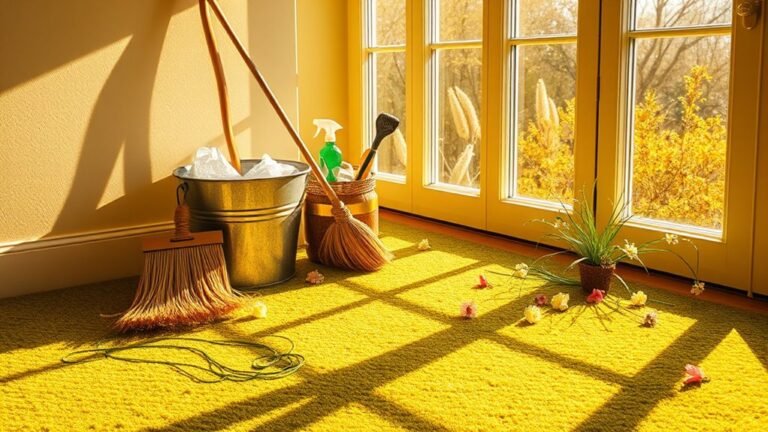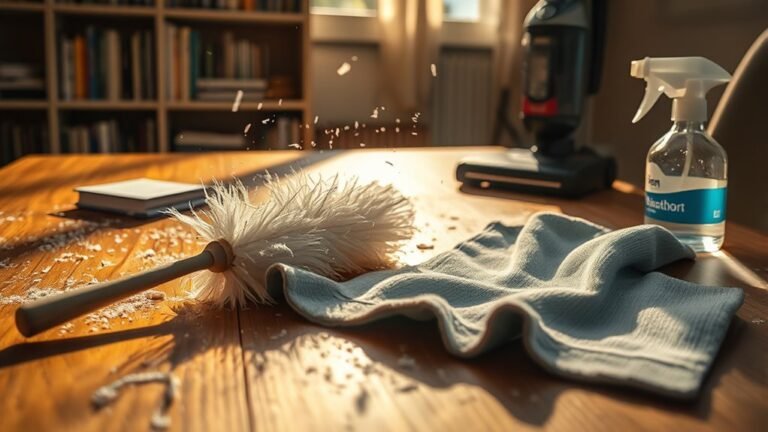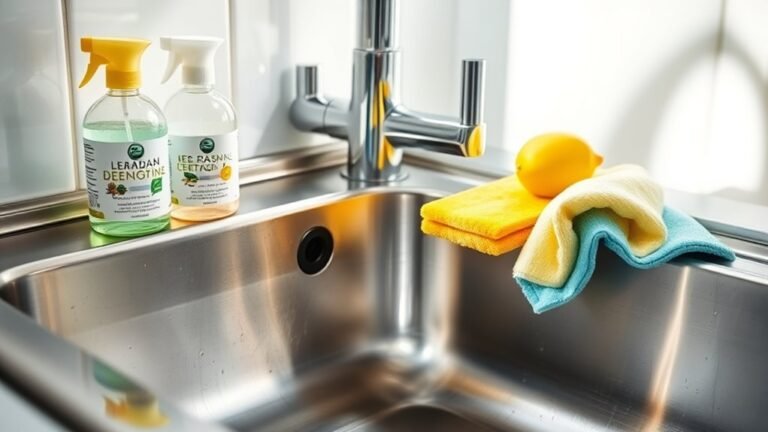Washing Windowsills Without Damage
You can wash your windowsills without causing damage by choosing gentle, eco-friendly cleaners and using microfiber cloths to avoid scratches. Start by removing loose dust with a soft brush or vacuum, then apply a mild solution like vinegar and water to break down grime. Wipe thoroughly and dry to prevent moisture buildup and mold. Regular cleaning and proper care protect the finish and keep your space fresh. Keep going to discover simple tips that make the process even easier.
Choosing the Right Cleaning Supplies

When it comes to choosing the right cleaning supplies for your windowsills, picking products that are effective yet gentle is key. You want eco friendly cleaners that won’t damage surfaces or leave harmful residues. These green options help you keep your space fresh without sacrificing your values or freedom to live toxin-free. Pair them with microfiber cloths, which are perfect for trapping dust and grime without scratching. Unlike harsh scrubbers, microfiber cloths let you clean thoroughly while preserving your windowsills’ finish. By selecting these supplies, you maintain control over your environment and avoid unnecessary chemicals. This smart approach guarantees your windowsills get spotless care, giving you the freedom to enjoy a clean home without compromise.
Preparing Your Windowsills for Cleaning
Selecting gentle cleaning supplies sets the stage for effective windowsill care, but preparing the surface properly guarantees the best results. Before you get started, take a moment to assess your window styles and sill materials. Different window designs and materials—wood, vinyl, metal, or stone—need unique attention. Remove any loose dirt or dust with a soft brush or vacuum to avoid scratches. Protect surrounding areas by laying down cloths or paper towels, especially if your sills are delicate or painted. If you have movable window parts, open them carefully to access every nook. Taking these preparatory steps lets you clean thoroughly without risking damage, giving you freedom to maintain your windowsills confidently and effectively.
Step-by-Step Cleaning Process

Although cleaning windowsills might seem straightforward, following a clear step-by-step process guarantees you won’t miss any spots or cause damage. Start by removing dust and debris with a soft brush or vacuum. Next, apply an eco friendly solution—like a mix of vinegar and water—to gently break down grime without harsh chemicals. Finally, wipe down with a microfiber cloth, making sure to dry thoroughly to prevent moisture buildup.
Keep these tips in mind for effective seasonal cleaning:
- Use gentle, natural products to protect surfaces
- Clean during mild weather to avoid rapid drying
- Focus on corners and edges where dirt accumulates
Preventing Damage and Mold Growth
Since moisture is a primary cause of damage and mold growth on windowsills, you’ll want to keep them as dry as possible after cleaning. Wipe down any excess water immediately to prevent lingering dampness that invites mold. For effective mold prevention, guarantee good ventilation around your windowsills—fresh air helps keep surfaces dry. You might also consider applying a protective sealant designed for your windowsill material; this surface protection forms a barrier against moisture and stains. Avoid using harsh chemicals that can degrade the finish, making your windowsill more vulnerable. By staying proactive with drying and sealing, you’re not just cleaning—you’re safeguarding your space, giving yourself the freedom to enjoy fresh, damage-free windowsills without worry. It’s all about smart care to keep mold at bay and preserve your surfaces.
Tips for Maintaining Clean Windowsills Regularly

Keeping your windowsills dry and protected is just the start. To truly enjoy the freedom of a fresh, clean space, you need consistent window maintenance. Establish a cleaning frequency that fits your lifestyle—too often can be tedious, but too rare lets dirt and damage build up.
Here are some tips to help you maintain clean windowsills regularly:
- Set a realistic cleaning schedule, like every two weeks, to prevent grime buildup.
- Use gentle, non-abrasive cleaners to protect surfaces and avoid damage.
- Wipe down windowsills after rain or humidity to prevent moisture issues.
Frequently Asked Questions
Can I Use Vinegar to Clean Windowsills Without Causing Damage?
You can definitely use vinegar to clean windowsills without causing damage if you use the right cleaning techniques. Vinegar benefits include its natural ability to cut through grime and disinfect, making it a great choice for a fresh, chemical-free clean. Just dilute vinegar with water to avoid any potential harm to paint or wood. You’ll enjoy an easy, effective way to keep your windowsills spotless while feeling free from harsh chemicals.
How Often Should I Deep Clean My Windowsills?
You should deep clean your windowsills every three to six months to keep them in top shape. Regular window maintenance prevents buildup and extends their lifespan without feeling like a chore. Of course, if you live in a dusty or rainy area, you might want to increase the cleaning frequency. Staying on top of it means you’ll enjoy clearer views and a fresher space, giving you the freedom to focus on what matters most.
Are There Any Eco-Friendly Cleaning Alternatives for Windowsills?
If you’re looking for eco-friendly cleaning alternatives, you’ll love using baking soda—it’s great for scrubbing away grime without harsh chemicals. Mix it with water to make a gentle paste. You can also add a few drops of natural oils like lemon or eucalyptus for a fresh scent and extra cleaning power. These options let you clean freely, knowing you’re protecting both your space and the planet.
What Should I Do if My Windowsill Paint Starts Peeling?
If your windowsill paint starts peeling, don’t stress. You’ll want to tackle the peeling paint by gently scraping off loose bits and sanding the surface smooth. Then, clean the area thoroughly before applying a primer designed for wood or metal, depending on your windowsill. Once dry, repaint with a quality exterior paint to guarantee durability. This windowsill repair lets you maintain your space your way, keeping things fresh without losing your freedom to choose.
Can Windowsills Be Cleaned With a Pressure Washer Safely?
Imagine trying to clean a delicate flower with a fire hose—that’s what using a pressure washer on windowsills can feel like. When reflecting on pressure washer safety, you’ve got to evaluate your window material carefully. Vinyl or metal might handle it better, but wood or painted surfaces risk damage. To keep your freedom to clean without wrecking your windowsills, opt for a gentle spray, and always test a small spot first.






